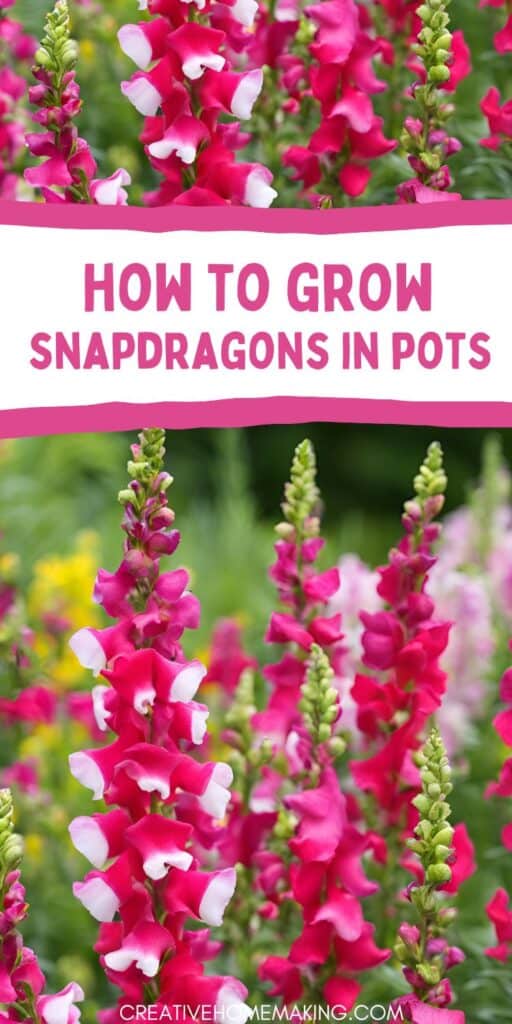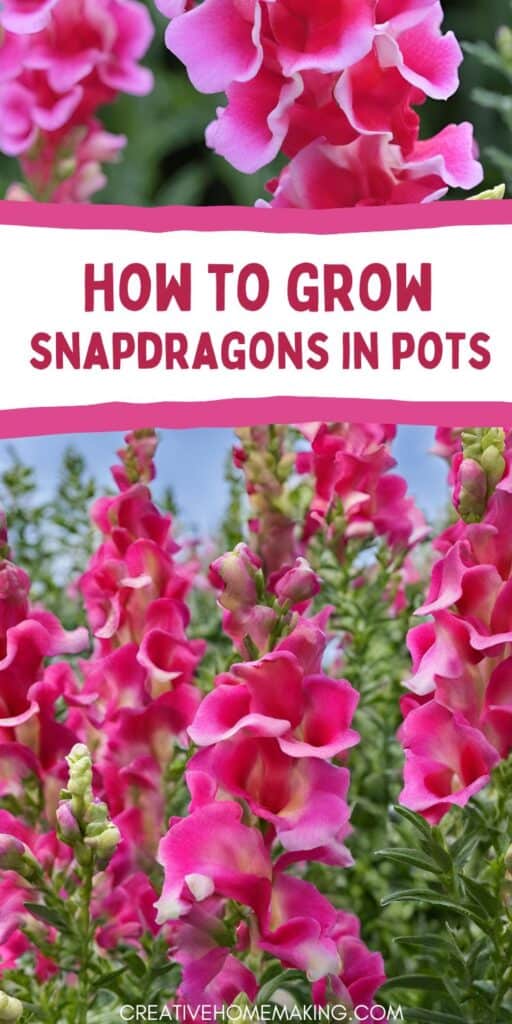Growing snapdragons in pots is a fun and rewarding experience. These colorful flowers thrive in containers, offering vibrant blooms that can brighten up any space.
This post may contain affiliate links.
Whether you have a small balcony or a spacious patio, snapdragons can fill your area with beauty and charm.
To get started, choose a pot that is at least 6-8 inches deep and has good drainage. Fill it with quality potting mix to help your snapdragons grow strong.
Related Article: Planting Snapdragons from Seed: A Guide to Growing Beautiful Blooms

With a little care, you’ll enjoy their delightful colors and unique shape throughout the blooming season.
Caring for your potted snapdragons is easy. Regular watering and a bit of fertilizer will keep them healthy and looking their best. With the right conditions, these flowers can provide stunning displays and attract happy pollinators to your garden.
Related Article: Best Companion Plants for Daffodils: Enhance Your Garden’s Beauty
Getting Started with Snapdragons
You can grow beautiful snapdragons in pots with the right choices in potting materials and plant varieties. Here’s what you need to know to begin your gardening adventure.
Choosing the Right Pot
Start by selecting a pot that is at least 6-8 inches deep. Snapdragons have a good root system, so depth is important. Make sure your pot has drainage holes to avoid water buildup, which can harm the plants.
You can use materials like terracotta or plastic. Terracotta is great for airflow, while plastic pots are lightweight and retain moisture better.
Related Article: How to Transplant Daffodils: A Simple Guide for Beautiful Blooms
For larger varieties, consider a pot that is at least 12 inches wide. The wider the pot, the more room your snapdragons have to grow. You can even group pots of different sizes for a lovely display.

Selecting Snapdragon Varieties
When choosing snapdragon varieties, think about size and color. There are dwarf varieties that grow about 6-10 inches tall and taller types that can reach up to 30 inches.
Related Article: How to Grow Zucchini in Containers Easily at Home
Some popular varieties include:
- Antirrhinum majus: Traditional tall snapdragons with various colors.
- Sonnet Series: Known for their compact size and strong stems.
- Madame Butterfly: Features unique double flowers and is great for pots.
Pick colors that match your garden or personal style. Mix and match varieties for an eye-catching look. Always check local growing zones to see which varieties will thrive in your climate.
Related Article: How to Plant Hyacinth Bulbs: A Simple Guide for Beautiful Spring Blooms
Snapdragon Care in Pots
Taking care of snapdragons in pots is simple and rewarding. Focus on the right soil, watering, light, and maintenance to help your plants thrive. Below are key aspects to keep your snapdragons healthy and vibrant.
Soil and Fertilization
Use well-draining potting soil for your snapdragons. A mix of peat moss, vermiculite, and compost works well. This blend allows for good drainage while providing essential nutrients.
Fertilize snapdragons every 4-6 weeks during the growing season. Use a balanced, water-soluble fertilizer. Options like a 20-20-20 or a specific flower fertilizer can help boost growth and blooming.
Make sure to follow package instructions for mixing. Over-fertilizing can harm your plants. Watch for yellowing leaves, a sign of too much fertilizer.
Related Article: How to Store Iris Bulbs: Simple and Effective Tips
Watering Requirements
Snapdragons prefer even moisture in their pots. Check the top inch of soil. If it feels dry, it’s time to water. You want the soil to be moist but not soggy.
Water your snapdragons thoroughly until water drains from the pot’s bottom. Make sure excess water can escape to prevent root rot.
In hot weather, you might need to water more often. Keep an eye on them, especially in warm conditions. Adjust your schedule based on rainfall and temperature.
Sunlight and Temperature
Snapdragons love sunlight. Place your pots where they can get at least 6 hours of direct sunlight each day. A sunny patio or balcony works well.
They prefer cooler temperatures, ideally between 60°F and 70°F. If it gets too hot, flowers may stop blooming. In this case, provide some afternoon shade during the hottest days.
Watch for signs of stress, such as droopy leaves. If you see this, consider moving your pots to a cooler, shadier location.
Pruning and Maintenance
Regular pruning helps your snapdragons stay healthy. Remove dead or faded flowers, also called deadheading. This encourages new blooms to grow.
You can also trim back the stems if they get too long. Cutting back allows for bushier growth and a fuller appearance.
Inspect your pots regularly for pests or diseases. Remove any affected areas promptly to prevent spreading. Keeping your plants clean and well-maintained helps them flourish.
Follow my spring bulbs board on Pinterest.




